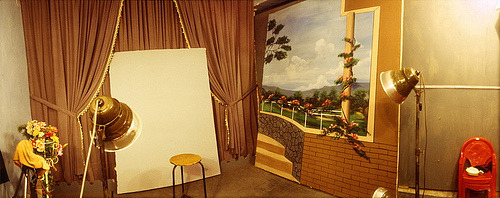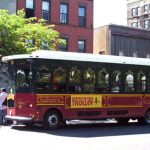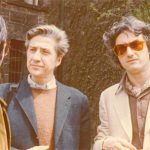Meet a NYFA Artist: Abby Robinson
Red Chair Sri Lanka (2002)
NYFA speaks with 2006 Photography Fellow Abby Robinson.
NYFA: Hi Abby, what are you working on and what’s coming up for you?
AR: In Spring 2009 I was one of ten international artists asked to participate in HomeBase IV, a public arts project in a vacant medical clinic on the Lower East Side. For it, I did an installation/performance/photography piece, turning my allotted space into a doctor’s office that morphed into a photo studio.
Home/Body Imaging was an entirely new way for me to make work (up until now I’ve worked alone, making limited-edition prints), yet it was also a surprising mash-up of past and present. My early studies in architectural history and interior design were prep for the installation. In my series Here & There, I photographed vibrantly colored interiors. The Martha-Stewart-cardiac-arrest-color of the clinic walls looked as if it had been made by melting old, so-not-PC “flesh” hued Crayolas. The strange palette reminded me a lot of places I’ve photographed in Asia (see my Here & There and In Camera series on my website). Scrutinizing and photographing body parts wasn’t exactly new either. I’ve been making self-portraits for more than 30 years (see the AutoWorks section of my website), plus there was my Perdue series (see website yet again).I’d been mulling over concepts of “public” versus “personal” since the time I worked with a private investigator.
For Home/Body Imaging, I realized that doctors and photographers can both examine people’s bodies at a distance usually reserved for lovers. In my performative role as “photo practitioner,” I peered at people’s selected body parts at incrediblyclose range. During the photo shoots, I heard confidential histories and stories (which I protected in my own HIPAA sort of way). The performance provided a unique opportunity to make photographs of special, often secret places entrusted to me by people with all types of bodies.
The way the piece worked was that people would sit in the waiting room, striking up conversations. Participants ranged widely in ethnicity and age and even included a few pets. Everyone filled out a medical/photo history questionnaire and presented it when they were called into the office. (In New York, quite a few of them thought I was actually a doctor, a holdover from the old clinic. This would have been funny and flattering if it didn’t provoke wonder and worry about their actual health care providers.)
We then discussed their body part selection. Reasons for their choices varied: they liked/disliked a particular spot; they wanted a representation of a place on their body they couldn’t easily see; a significant other or friends characterized them by a specific feature; or a body part reminded them of a family member or sparked a vivid memory.
A digital photo was taken in the studio, immediately printed out in the office, and placed in a plastic badge attached to a lanyard. The image was then worn around the neck like a VIP pass by the photo donor, with the badges creating further conversation among visitors. The participants left with a memento-which many of them kept long after my clinic had closed.
Re commercial work: I’ve been hired by Hauser and Wirth Gallery to shoot art for various books and catalogs. This has made me feel exceedingly lucky because it’s given me an up-close and personal look at the work of artists I very much admire and find inspiring: Eva Hesse, Dieter Roth and Bjorn Roth, and Ida Applebroog.
Also, I’m writing about photography again. I did several articles awhile back for Asian Art News on Vietnamese photography (these were a byproduct of an Asian Cultural Council grant where I lived and worked in Vietnam for a year). Now I’m a contributing editor on the Trans-Asia Photography Review (TAP). For its launch I wrote on Three Shadows Photography Art Centre in Beijing where I did a residency in 2008; for the second issue:I interviewed Rahaab Allana, the curator of the New Delhi-based Alkazi Foundation.
In fall 2010, my article, “An Overview of Contemporary Sri Lankan Cinema: a Photographic Essay,” was published in South Asian Popular Culture. This piece resulted from a research project I did on an American Institute for Sri Lankan Studies fellowship. I know, who even knew Sri Lanka had a film industry?
NYFA: How did being in Shanghai influence you? How about your students?
AR: Let’s start with my students-there were 8, ranging in age from 20-60, and with the exception of one, none had been in China before. So it was both a thrill and a challenge for them to shoot and tackle a project in a foreign venue. One woman arrived thinking she’d continue an architectural series she’d done in New York. However, that required blue skies and unfortunately it rained a lot while we there. She was really frustrated but then found a whole new direction for her photography that continues to excite her. The oldest member of the group, who’d previously done mostly landscapes, started a project that has to do with closeted gay life. He’s so into this that he returned to Shanghai to photograph Gay Pride Week in October plus had a show of the project to date. I think he’ll be going back a number of times so that he can–as he should-get a book out of this. Another young woman who’s Indian-American dealt with identity issues by putting on a sari (which she doesn’t usually wear). She was besieged by people wanting to have their pictures taken with her; her ethnicity was suddenly clear-cut.
I think all the students enjoyed their experience, were energized by it and benefited from meeting people–Shanghainese and expats–living and working in the city.
As did I. I always find that my work changes and thrives when exposed to new people and new photographic methodologies. Aside from teaching there, I did a second iteration of my Home/Body Imaging at the Yongkang Lu Art Center in a gallery/storefront situation and it was fascinating to see what things overlapped with the New York experience and what things were very, very different. As I hope to continue this piece, Shanghai was both a testing ground and avatar for subsequent installations.
NYFA: Who or What is your biggest influence right now?
AR: One of my big influences-and it’s been for years now-is travel, because I wind up being in the presence of things that surprise me. Alexey Brodovitch, the renowned art director at Harper’s Bazaar, was known for his famous dictum: “Astonish me.” When I travel I get to be astonished; I see things that make my eyeballs spin around in their sockets.
NYFA: Do you move through different obsessions?
AR: The only things that distinguish one artist from another are his/her obsessions, no? Though you could call them passions. So the answer is yes; and mine tend to be very long lasting.
Every one of my series has gone on and on for years.
NYFA: Is there a reaction you hope to invoke in those who view your work?
AR: Stendhal syndrome?
NYFA: What is an indulgence for you?
AR: I’m either lacking in sufficient puritan principles, imagination and/or a certain type of guilt gene because nothing I do seems to be one.
NYFA: What techniques and skills are unique to your process?
AR: A pretty consistent and constant ability to maintain and exercise curiosity.
Stealth–though the quality of this is mutable; different projects require different modes. For the work I did during my detective period, my m.o. was more a matter of acting quietly and sometimes sneakily and surreptitiously. Now that I’m taking very close up picture of someone’s body part, I practice something akin to doctor-like discretion. Last but not least, a sense of humor that functions in tandem and ironically with seriousness.
NYFA: How did you initially become involved in photography?
AR: Pretty much by accident. Initially I found cameras with their f-stops and shutter speeds pretty daunting.
I went to Barnard, graduated with a degree in architectural history, spent a year working in publishing and then applied to Pratt. One of the home test questions was “do something in the medium in which you feel most competent,” which I could only interpret as “do something in the medium in which you feel least incompetent.” By then I had some photographer friends and they told me what to shoot and how to shoot it. As for the other questions on the test, I used Larry Rivers’ advice: “if you can’t draw, trace.” With what could only be described as a schizophrenic portfolio, I was miraculously accepted. Because I already had a BA, Pratt suggested I do three catch-up undergrad semesters and then go for an MFA in Interior Design. Since that seemed related to architectural history, I figured what the hell. Then I took a photography class as an elective-thinking it a good way to document design details–and for the first time actually liked using a camera.
What truly kick-started my career was a remark by my photoprofessor Philip Perkis. My first semester as a grad student, I was working like a maniac on my design problems, freelance editing a book for Viking Press (where I worked after I got my undergrad degree), swimming a mile a day, and trying to live a life. One day I went to the pool, swam a lap–in what I remember as being truly gorgeous form–and then wanted to die. One visit to the doctor later, I had mononucleosis. All of my teachers were understanding but Philip said, “You can lift a camera, right? So, photograph in bed! ” It was one of those aha moments. I thought, “wow, you can be a slug and still have a career; you can feel lousy and still make something meaningful.” So, I got out of bed, changed my major to photography and never regretted it.
My 35+-year ongoing self-portrait series called AutoWorks grew out of my photographing in bed. One of the reasons for sticking with it was that I didn’t want to feel I had to travel to find subject matter and for good or ill, I’m always around. That work is in black and white, and the photos are small and intimate. I figure this body of work will continue until I’m too old and feeble to hit the shutter. I also like doing them because the photographer gets to be director,actor, observer, subject and/or prop, and the camera functions as companion and accomplice. The pictures are never displayed chronologically since I don’t think the point of the work is diaristic. Instead, by combining pictures throughout the years, the images parallel memory itself– circular, paradoxical, ironic, sly, and funny. You get to honor time and truth as well as deconstruct them. The series is lucid without being linear.
One other aspect of my career worth mentioning-and equally accidental-is writing. As I mentioned earlier, one of my jobs right out of grad school was working with a private eye. This was not quite what I had imagined as a career path. The first case, Iworked oninvolved adultery and spending five nights on the roof of the Ansonia Hotel. As a goof I wrote something about this experience; to make a long, loopy story short, I wound up showing this to an agent and this episode became the basis for the published novel The Dick and Jane. Which led to food and travel writing and more recently articles about Asian photography.
NYFA: Do you have any advice for aspiring photographers?
AR: Rethink your ideas of good taste and experiment. Work your ass off, taking to heart Chuck Close’s notion, “Inspiration is for amateurs.” Be the champion of your own work rather than wait for others to champion it. Never apologize for work you’re presenting and know that you’ll always need courage and daring.
And stop using the word “like.” Plus there’s my no-no list I wrote up this year for my classes.
NYFA: How do you view your role as an artist, culturally and/or socially?
AR: My role–both culturally and socially–is to make the best work I can; try to make all the 1/15th to 1/500th of a second that I’ve spent taking photos produced images that transform the way some viewers see and experience the world; to make art and to teach in such a way that helps open up new possibilities for thought, creativity and vision and/or lifts or tickles the spirit.
NYFA: How has the Fellowship affected you, your work, and/or your career?
AR: Of course it’s delicious to have your work applauded and appreciated by an institution that values the arts. How cool is a boost-monetary and emotional– that rewards you for your art practice and for things you worked so hard on in the past so you can feel encouraged and daring enough to make new, different and hopefully even better work in the future.
Plus you become part of (and feel part of too) a community, one whose administrators absolutely support the arts and whose fellow members are artists whose work I admire and respect. The community continues to expand and with it my horizons since I’m often introduced to the work of practitioners whom I don’t know. Last but not least, I like that NYFA has programs and listings and staff that continue to assist grantees.
P.S. I just received news that I selected as a winner in the Personal Photography category in the PDN (Photo District News) Photo Annual 2011. The announcement will be run in May.
For more information on Abby Robinson, visit her website.





